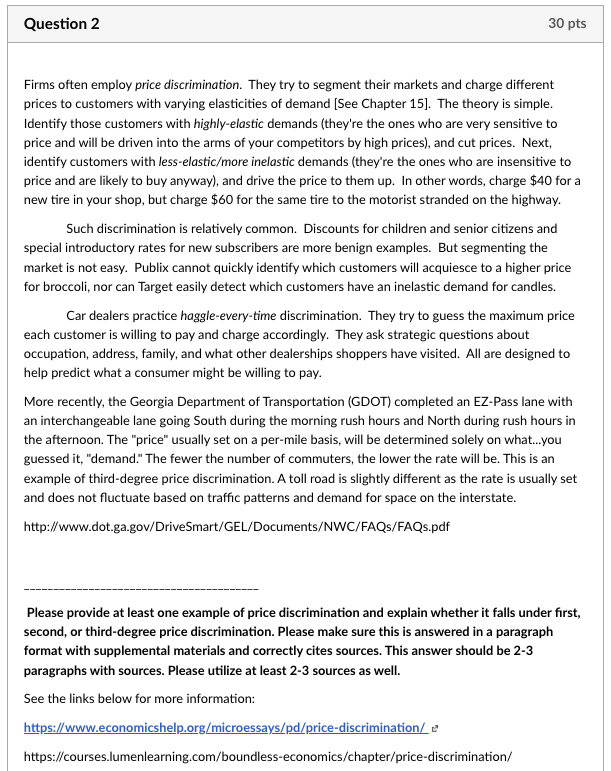Home /
Expert Answers /
Economics /
firms-often-employ-price-discrimination-they-try-to-segment-their-markets-and-charge-different-pr-pa384
(Solved): Firms often employ price discrimination. They try to segment their markets and charge different pr ...
Firms often employ price discrimination. They try to segment their markets and charge different prices to customers with varying elasticities of demand [See Chapter 15]. The theory is simple. Identify those customers with highly-elastic demands (they're the ones who are very sensitive to price and will be driven into the arms of your competitors by high prices), and cut prices. Next, identify customers with less-elastic/more inelastic demands (they're the ones who are insensitive to price and are likely to buy anyway), and drive the price to them up. In other words, charge \( \$ 40 \) for a new tire in your shop, but charge \( \$ 60 \) for the same tire to the motorist stranded on the highway. Such discrimination is relatively common. Discounts for children and senior citizens and special introductory rates for new subscribers are more benign examples. But segmenting the market is not easy. Publix cannot quickly identify which customers will acquiesce to a higher price for broccoli, nor can Target easily detect which customers have an inelastic demand for candles. Car dealers practice haggle-every-time discrimination. They try to guess the maximum price each customer is willing to pay and charge accordingly. They ask strategic questions about occupation, address, family, and what other dealerships shoppers have visited. All are designed to help predict what a consumer might be willing to pay. More recently, the Georgia Department of Transportation (GDOT) completed an EZ-Pass lane with an interchangeable lane going South during the morning rush hours and North during rush hours in the afternoon. The "price" usually set on a per-mile basis, will be determined solely on what...you guessed it, "demand." The fewer the number of commuters, the lower the rate will be. This is an example of third-degree price discrimination. A toll road is slightly different as the rate is usually set and does not fluctuate based on traffic patterns and demand for space on the interstate. http://www.dot.ga.gov/DriveSmart/GEL/Documents/NWC/FAQs/FAQs.pdf Please provide at least one example of price discrimination and explain whether it falls under first, second, or third-degree price discrimination. Please make sure this is answered in a paragraph format with supplemental materials and correctly cites sources. This answer should be 2-3 paragraphs with sources. Please utilize at least 2-3 sources as well. See the links below for more information: https://www.economicshelp.org/microessays/pd/price-discrimination/ https://courses.lumenlearning.com/boundless-economics/chapter/price-discrimination/
Expert Answer
"Airline travel and time of departure" Airlines charge different prices depending on the season and day of the week. During the peak holiday season in August and Easter, the price will be higher because demand is greater and more inelastic. Flights t
